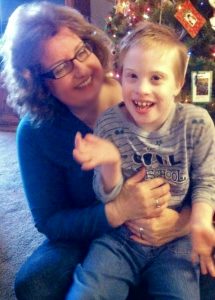What’s Out There for Children that Have Special Needs?
Homeschool curriculum has come a long way since the first few bold families decided to teach their children at home. Back then they were using castoff textbooks from second-hand stores and a good set of encyclopedias. The search term “homeschool curriculum” returns a mind-boggling assortment of choices in our day!
There is a smaller selection designed specifically for students with special needs. No curriculum will be a perfect fit for every student, and this is especially true for children who learn differently. Whether you choose a mainstream homeschool curriculum or one developed for special needs, it falls to the teaching parent to modify it to suit their own child’s learning style.
My son has a dual diagnosis of Down syndrome and autism. As well as the mainstream curriculum, I have tried using a few programs that target the challenges learners with Down syndrome typically experience. And I have tried many programs designed for homeschooled students with autism. Most of them have taught me a lot about how these children learn, and most of them have needed to be modified somewhat for my own child.
Learning Styles for Children with Special Needs
Since my son is a kinesthetic learner, he needs to touch, feel, and manipulate things to understand them. Although I would love to have a collection of worksheets with the correct answers neatly circled by him, I have had to content myself with photographing or videotaping Joshua choosing the “smallest” toy tiger or the “tallest” giraffe. That type of activity is more meaningful to him than circling drawings of the same animals on a worksheet.
My son is also a conversationalist. Many worksheets are done out loud, without a pencil contacting paper at all. If a worksheet presents three pictures and instructs the student to circle the picture that begins with the letter “A”, Joshua can quickly point to the astronaut and proudly tell me about a few more letter A words he has thought of himself.
This provides more practice than if I were to insist he manage to circle the astronaut. The purpose of this particular worksheet (to practice words beginning with the letter “A”) can be accomplished conversationally.
Motor Skills in Children with Special Needs
Speaking of circles, Joshua can’t draw them yet. His fine motor skills do not allow him to clutch a pencil for long, nor to press very hard when trying to write. The resulting light pencil marks are not motivating to him. When he uses a marker, he can make bold strokes with little effort, keeping his interest for a longer period of time.
Instead of drawing circles, I allow him to make any mark he is able to manage to indicate the correct answer. Bingo dabbers are great alternatives to drawing circles.
Joshua uses large sweeps of his arm to “air print” his name in enormous, invisible letters. So far, he still finds it difficult to print his name on paper. His physical therapist suggested stickers to exercise the small muscles in his hands, so I printed several pages of file folder labels with his name on them. When he needs to write his name, he pulls off a sticker and uses that instead.
I love that this modification, which compensates for his inability to write his name, also prepares his hand muscles to be able to write in the future.
Repetition is Helpful when Dealing with Special Needs
Some students require constant practice and a lot of repetition to maintain skills once they are acquired. I place page protectors over worksheets that I do expect to use, and my son uses dry erase markers to do them over and over again.
File folder games are another option for continual practice of the same concept. There are free printable file folder games available online, or you can make your own from a worksheet. Paste the worksheet inside a file folder and cut each of the potential answers out individually. (You might want to print these on cardstock or laminate them.) Now the student can do the worksheet multiple times, placing the correct answer on the question.
Distractions that Affect Children with Special Needs
The same colorful, fun worksheets that my older children preferred are too distracting for Joshua. He needs to concentrate on just the task at hand. If a worksheet has four problems, I will cover the three that are not being used with a plain piece of paper, allowing him to focus on the remaining problem by itself. I have made cardstock templates for our most frequently used worksheet layouts.
Because my son is so easily distracted, he responds well to our own homemade books, simply created from three or four pieces of stacked and folded paper. I write a very short sentence in large letters on one page, all by itself. On the next page, I paste or draw a picture that pertains to the sentence. In this way, he must actually read the words, without distraction or cues from the picture, and then the picture serves as a reward for reading the sentence.
Suggested Products
The Vision of Children with Special Needs
My child’s vision is very poor, and his sensory issues make wearing glasses something we practice for just a few minutes several times a day. I try to plan something interesting to do while he is wearing his glasses. A fun snack is a good choice since Joshua finds food motivational.
Glasses practice and academics would be too much at once for my learner. Joshua has an amazing rote memory, able to quickly master things like names of state capitals when presented on flashcards. Purchased flashcards are usually both too “busy” and much too small, so I make large flashcards for him in bold print. These flashcards are often the size of an entire piece of card stock, although he can also manage with one-third of a sheet in most cases.
Children with Special Needs Require Movement
Many children with developmental delays also have ADD or ADHD, and my son is no exception. Expecting him to sit still for more than a minute or two is unrealistic. He enjoys sitting on an exercise ball and bouncing once for each letter as he spells words aloud. Standing on a mini trampoline to practice simple addition, he can count his jumps to indicate his answer.
Another practical way to help a child with ADHD use a rhythm instrument for syllable practice, banging out a beat to match each syllable in a word.
When you are reading a book to your child, try having them perform a motion every time a certain word is read. For example, you might have them clap once every time they hear the word “George” in a Curious George book, or have them act out an animal and make its sound when you read any animal name. This not only burns off the extra energy but encourages your child to pay attention to the story.
Backward Chaining to Help You Teach
Backward chaining is when you teach a skill by doing most of it for your child, leaving one small step for them to complete. The next time, you might leave the last two steps for them to do themselves. This method is often used to teach life skills like bed making, but it works well for art projects, too.
My son can’t draw a smiling face. However, he can add the eyes if I draw a circle for a head, a dot for a nose, and a smiling mouth. He now knows there should be two eyes and approximately where to place them. So I’ll soon take a step backward and leave off both eyes and the nose for him to complete.
Modified Equipment for Children who Have Special Needs
A short pencil forces a student to use a tripod pencil grasp. Triangular pencil grips can also encourage this. A student whose fine motor skills aren’t quite developed enough yet for the proper grip might struggle with holding the pencil at all. Fat toddler pencils and crayons help. But, if your student is older, he may prefer a weighted pencil that looks more like a typical one.
There are scissors that accommodate two sets of fingers: the teacher’s and the student’s. There are scissors that spring open again after being squeezed, eliminating one set of hand motions for a beginning cutter. Glue sticks are obvious alternatives to messy liquid glue or paste. The ones with colored glue help the student remember where he has applied glue.
Every child is different and every child has their own unique needs. However, with a little creativity, parents can come up with ways to modify curriculum to their child’s advantage.
Meet the author – Kelly Stone!
Kelly Stone is a mom to six children whose ages range from 14 through 35. She has homeschooled for over twenty years. Kelly works as a freelance writer and educational advisor from her home office in Oregon.
Her nest is rapidly emptying. But she still shares it with her two younger children, chickens, rabbits, quail, lizards, frogs, and the family dog, Ruby. Kelly’s preferred activities all tend to include the word “home”: homeschool, homemade, homesteading, home office, homegrown, and good home cooking!






